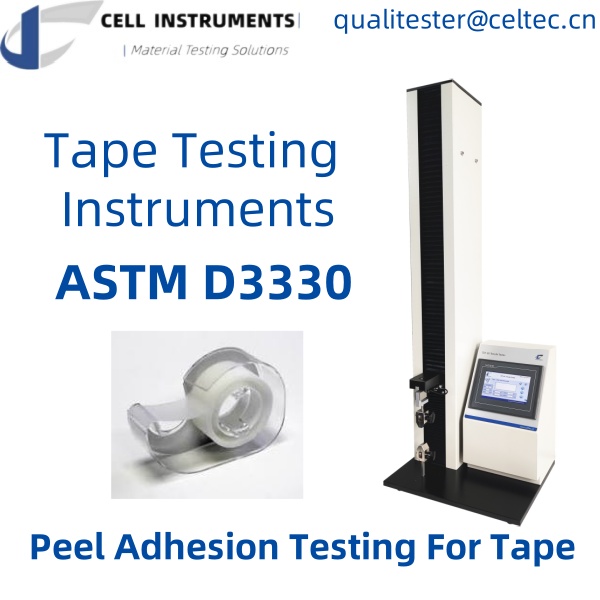ASTM D3330 Peel Adhesion Test Method: A Comprehensive Guide to Adhesive Testing Standards
The peel adhesion test is an essential procedure for evaluating the bonding strength of pressure-sensitive tapes, adhesives, and other materials that require accurate adhesion testing. ASTM D3330 is one of the most widely recognized standards for these tests, providing reliable results for industries such as packaging, medical, automotive, and more.
1. Application of Pressure-Sensitive Tape
Pressure-sensitive tapes (PST) are versatile adhesive products. These tapes come in various types, such as single-coated, double-coated, transfer, foam, and release liner tapes, each designed for specific applications. Single-coated tapes are commonly used for general bonding, while double-coated tapes are ideal for mounting and laminating. Transfer tapes are used for precise bonding, and foam tapes offer shock absorption and sealing properties. Specialty tapes are also tailored for tasks like medical dressing or high-temperature resistance.
The applications of pressure-sensitive tapes are wide-ranging. In packaging, they are essential for sealing boxes and cartons, while in medical devices, they help ensure sterile packaging and secure seals. These tapes must perform under various conditions, including temperature changes, humidity, and mechanical stress. Peel adhesion testing ensures these tapes maintain their strength and durability, making them reliable for industries where safety, performance, and longevity are critical.
2. Peel Adhesion Test Method for Pressure-Sensitive Tape
Peel adhesion testing measures the strength of the bond between a tape and the surface to which it is applied. This test is performed by pulling the tape at a specific angle and speed to measure the force required to separate it. The results help determine whether the adhesive is strong enough for the intended application. ASTM D3330 provides a standardized method for performing peel adhesion tests on pressure-sensitive tapes.
3. Peel Adhesion Test Standard – ASTM D3330
Definition of Peel Adhesion Test
The peel adhesion test measures the force required to peel a pressure-sensitive tape from a substrate (such as plastic, metal, or paper) at a specific angle and speed. The results give an indication of the tape’s bonding strength and its ability to resist shear forces. ASTM D3330 outlines a standardized procedure to ensure consistency and reliability in testing.
Tape Peel Test – ASTM D3330 Method A
Testing Process
- Tape Application: A sample of the pressure-sensitive tape is applied to the test substrate (such as metal, glass, or plastic) under controlled conditions of temperature and humidity.
- Peel Test: The tape is peeled away from the substrate at a 180° angle, and the force required for peeling is measured.
- Data Collection: The force is recorded continuously, and the average peel strength is calculated. This data helps determine whether the tape meets the required performance specifications.
Advantages and Limitations of Method A
Advantages:
- Simple and widely accepted test method
- Suitable for a variety of single-coated tapes
- Provides consistent, repeatable results
Limitations:
- May not simulate real-world conditions where tapes are exposed to varied angles or forces
- Primarily used for single-coated tapes, limiting its application to certain products
Other ASTM D3330 Test Method
ASTM D3330 also includes several other testing methods, each tailored to specific types of adhesive tapes:
- Method B: 180° peel test for measuring the adherence of a single-coated tape to its backing.
- Method C: 180° peel test for measuring the adhesion properties of double-coated tapes.
- Method D: 180° peel test for measuring the adherence of the release liner to the adhesive of either single or double-coated tapes.
- Method E: 180° peel test for adhesive transfer tapes, which do not have a backing material.
- Method F: 90° peel test for measuring the adhesion properties of single-coated tapes.
Each of these methods provides a nuanced approach to evaluating different types of adhesive tapes, ensuring that a broad range of products can be tested effectively.
4. Other Peel Adhesion Test Standards for Pressure-Sensitive Tape
PSTC 101 Test Methods for Pressure-Sensitive Adhesive Tapes
ISO 29862 Self-adhesive tapes — Determination of peel adhesion properties
FAQ
1. What is the peel adhesion test, and why is it important?
The peel adhesion test measures the force required to peel a pressure-sensitive tape from a substrate, ensuring that the tape provides adequate bonding strength for its intended application.
2. How is the ASTM D3330 peel adhesion test performed?
The ASTM D3330 peel adhesion test is performed by applying the tape to a substrate and peeling it at a specified angle (typically 180° or 90°) at a constant speed. The force required to peel the tape is recorded, and this force is used to evaluate the tape’s adhesion strength.
4. Can peel adhesion testing be done for other types of adhesives besides tape?
Yes, peel adhesion testing is applicable to a wide range of adhesive products beyond tape, including labels, medical adhesives, bonding agents, and other surface-mounted adhesives. The test procedures can be adapted depending on the type of adhesive and substrate being used.

